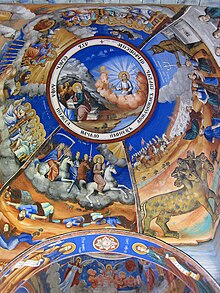Apocalypse

| Part of a series on |
| Eschatology |
|---|
Apocalypse (from
Eschatology, from Greek eschatos, last, concerns expectations of the end of the present age,[7] and apocalyptic eschatology is the application of the apocalyptic world-view to the end of the world, when God will bring judgment to the world and save his followers.[8] An apocalypse will often contain much eschatological material, but need not: the baptism of Jesus in Matthew's gospel, for example, can be considered apocalyptic in that the heavens open for the presence of a divine mediator (the dove representing the spirit of God) and a voice communicates supernatural information, but there is no eschatological element.[9]
Scholars have identified examples of the genre ranging from the mid-2nd century BC to the 2nd century AD,
Definition and history
"Apocalypse" has come to be used popularly as a synonym for catastrophe, but the Greek word apokálypsis, from which it is derived, means a revelation.[13] It has been defined by John J Collins as "a genre of revelatory literature with a narrative framework, in which a revelation is mediated by an otherworldly being to a human recipient, disclosing a transcendent reality which is both temporal, in that it envisages eschatological salvation, and spatial, insofar as it involves another, supernatural world."[14] Collins later refined his definition by adding that apocalypse "is intended to interpret present, earthly circumstances in light of the supernatural world and of the future, and to influence both the understanding and the behaviour of the audience by means of divine authority."[14]
The genre of Jewish and Christian apocalypse flourished c.250 BC-250 AD, but its antecedents can be traced back much further, in the Jewish prophetic and wisdom traditions (e.g.,
Characteristics

Apocalyptic revelations are typically mediated through such means as dreams and visions (the ancient world did not distinguish between these), angels, and heavenly journeys.[2] These serve to connect two sets of axes, the spatial axis which has God and the heavenly realm above and the human world below, and the temporal axis of the present and the future.[2] The revelation thus demonstrates that God rules the visible world, and that the present days are leading to an end-time in which divine justice will be done and God's rule will become visible.[2] Mythic images with their roots in texts from the Hebrew Bible and rich in symbolic meaning are a significant characteristic of the genre.[3] Further characteristics include transcendentalism, mythology, pessimistic cosmological and historical surveys, dualism (including a doctrine of two ages and the division of time into periods), numerology (e.g., the "number of the beast" in Revelation), claims of ecstasy and inspiration, and esotericism.[4]
With the exception of the
Jewish apocalypses
Canonical (including proto-apocalyptic)
Non-canonical
- 3 Enoch
- Apocalypse of Abraham
- Apocalypse of Adam
- Apocalypse of Moses
- Apocalypse of Sedrach
- Apocalypse of Zephaniah
- Apocalypse of Zerubbabel
- Aramaic Apocalypse
- Gabriel's Revelation
- Genesis Apocryphon
- Greek Apocalypse of Baruch
- Greek Apocalypse of Daniel
- Greek Apocalypse of Ezra
- Sefer Elijah
- Syriac Apocalypse of Baruch
Christian and gnostic apocalypses
Canonical (New Testament)
- Matthew 24
- The Sheep and the Goats
- Mark 13
- 2 Thessalonians 2
- 1 Timothy 4
- 2 Peter 3
- Jude 14–15
- Book of Revelation
Non-canonical
- Apocalypse of Golias
- Apocalypse of Paul
- Apocalypse of Peter
- Apocalypse of Pseudo-Methodius
- Apocalypse of Samuel of Kalamoun
- Apocalypse of Stephen
- Apocalypse of Thomas
- Coptic Apocalypse of Elijah
Gnostic
- Gnostic Apocalypse of Peter
- First Apocalypse of James
- Second Apocalypse of James
- Coptic Apocalypse of Paul
See also
References
- ^ Carey 2012, p. 4.
- ^ a b c d Najman 2014, p. 37.
- ^ a b Reynolds 2011, p. 45-46.
- ^ a b Lewis 2004, p. 12.
- ^ a b Linton 2006, p. 35.
- ^ a b Redditt 2008, p. 180.
- ^ Carroll 2000, p. 420.
- ^ Crawford 2000, p. 73.
- ^ Foster 2020, p. 81.
- ^ a b Arnold 2007, p. 80.
- ^ Collins 1984, p. 106.
- ^ Najman 2014, p. 40.
- ^ a b Lewis 2004, p. 7.
- ^ a b Lewis 2004, p. 17.
- ^ Crawford 2000, p. 72.
- ^ Crawford 2000, p. 72-73.
- ^ Aune 1983, p. 109.
Sources
- Arnold, Bill (2007). "Old Testament Eschatology and the Rise of Apocalypticism". In Walls, Jerry L. (ed.). The Oxford Handbook of Eschatology. Oxford University Press. ISBN 978-0-19-988359-2.
- Aune, David (1983). Prophecy in Early Christianity and the Ancient Mediterranean World. Eerdmans. ISBN 9780802806352.
- Carroll, John T. (2000). "Eschatology". In Freedman, David Noel; Myers, Allen C. (eds.). Eerdmans Dictionary of the Bible. Eerdmans. ISBN 9789053565032.
- Carey, Greg (2012). Ultimate Things. Chalice Press. ISBN 9780827238183.
- Collins, John J. (1984). Daniel: With an Introduction to Apocalyptic Literature. Eerdmans. ISBN 9780802800206.
- Crawford, Sidnie White (2000). "Apocalyptic". In Freedman, David Noel; Myers, Allen C. (eds.). Eerdmans Dictionary of the Bible. Eerdmans. ISBN 9789053565032.
- Foster, Paul (2020). "The Eschatology of the Gospel of Matthew". In Ferda, Tucker; Frayer-Griggs, Daniel; C. Johnson, Nathan (eds.). "To Recover What Has Been Lost". BRILL. ISBN 9789004444010.
- Lewis, Scott M. (2004). The Mother of All Theology. Paulist Press. ISBN 9780809142286.
- Linton, Gregory L. (2006). "Reading the Apocalypse as Apocalypse". In Barr, David L. (ed.). The Reality of Apocalypse: Rhetoric and Politics in the Book of Revelation. Society of Biblical Literature. ISBN 9781589832183.
- Najman, Hindy (2014). "The Inheritance of Prophecy in Apocalypse". In Collins, John Joseph (ed.). The Oxford Handbook of Apocalyptic Literature. Oxford University Press. ISBN 978-0-19-985649-7.
- Redditt, Paul L. (2008). Introduction to the Prophets. Eerdmans. ISBN 9780802828965.
- Reynolds, Bennie (2011). Between Symbolism and Realism: The Use of Symbolic and Non-Symbolic Language in Ancient Jewish Apocalypses 333-63 B.C.E. Vandenhoeck & Ruprecht.
